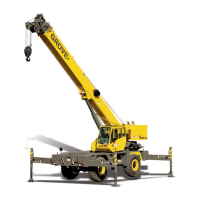Manitowoc Published 07-19-16, Control # 249-01 1-71
2250 SERVICE/MAINTENANCE MANUAL INTRODUCTION
MAX-ER
®
2000 DESCRIPTION OF
OPERATION
MAX-ER Components
The line legend for all schematic is shown in Figure 1-44.
The MAX-ER 2000 combines a model 2250 crane with mast
and boom-butt-mounted load drum with a wheeled
counterweight assembly. The luffing jib attachment is also
usually part of most MAX-ER 2000s. See Section 3 of MAX-
ER 2000 Operator Manual for MAX-ER attachment
operation instructions or luffing jib attachment operation
instructions.
The MAX-ER 2000 wheeled counterweight assembly
consists of the following components (see Figure 1-45
):
• Wheeled Counterweight Assembly—This is suspended
from the mast by straps and hydraulic cylinders. An arm
connects the wheeled counterweight trailer to the rear of
the crane. The trailer wheels can be turned to permit the
crane to travel or swing when the trailer wheels are on
the ground.
• Counterweight Straps and Cylinders—These suspend
the wheeled counterweight assembly from the mast.
The strap cylinders automatically raise and lower the
counterweight in response to changes in the load
(weight of lifted load and boom angle).
• Load-Sensing Pin—Located in the gantry left side
backhitch, measures load tension created by the lifted
load. The load-sensing pin sends a proportional
0.8 to 8.0 V signal to the crane’s PC. The crane’s PC
enables the electrical and hydraulic systems to
automatically extend and retract the counterweight strap
cylinders to raise and lower the wheeled counterweight
assembly in response to changes in the backhitch
tension.
• Crane Programmable Controller (PC)—This controls the
crane and MAX-ER systems.
• MAX-ER Programmable Controller (PC)—This operates
the attachment’s electrical and hydraulic systems to
automatically raise and lower the wheeled
counterweight assembly in response to electronic
signals from the load-sensing pin, pressure senders,
and cylinder limit switch.
• Strap Cylinder Limit Switch—This limits how high the
wheeled counterweight assembly is raised.
MAX-ER Hydraulic Attachments
See Hydraulic and Air Systems Section 2 for the Hydraulic
Schematic.
Hydraulic attachments include the wheeled counterweight
trailer cylinders, mast stop cylinders, jib strut cylinders, and
load drum 9 in the boom butt. Hydraulic fluid used to operate
the attachments is from the auxiliary pump on the crane. In
MAX-ER mode, hydraulic fluid used to operate the drum 9
system is from the travel system pumps, boom hoist charge
pump, and fan auxiliary pump.
A hydraulic system that is open means fluid can flow in the
circuit. Each hydraulic solenoid valve is assigned an HS
number. The HS number identifies each hydraulic solenoid
valve.
Table 1-4. Hydraulic Solenoid (HS) Valves
Auxiliary Pump
The main crane’s hydraulic tank supplies hydraulic fluid for
all attachments. The auxiliary pump draws fluid from the
crane’s hydraulic tank through a suction manifold. The
auxiliary pump supplies pressurized hydraulic fluid between
152 bar (2,200 psi) and 200 bar (2,900 psi) to the mast
accumulator system, MAX-ER accessory valve, and crane’s
accessory valve. The auxiliary pump’s pressure is monitored
and controlled by the mast accumulator pressure sender.
Line Legend for All Schematics
High-Pressure Hydraulic, Positive Electrical,
Manifold Air
Negative Electrical (ground)
Low-Pressure Hydraulic, Electrical Signal,
Exhaust Air
Control or Pilot Pressure Hydraulic,
Regulated Air
Case Return Pressure Hydraulic
Hydraulic Suction Manifold Pressure
Not Active Line or Circuit
FIGURE 1-44
HS-40 Strap Cylinders Lower (extend)
HS-41 Strap Cylinders Raise (retract)
HS-42 Swing/Crab—Steering Cylinder Extend
HS-43 Straight—Steering Cylinder Retract
HS-44 Left Jack Extend
HS-45 Left Jack Retract
HS-46 Right Jack Extend
HS-47 Right Jack Retract
HS-48 Center Jack Extend
HS-49 Center Jack Retract
HS-50 Tongue Cylinder Extend
HS-51 Tongue Cylinder Retract
HS-52 Steering Pins Engage
HS-53 Steering Pins Disengage
HS-54 Crawler Travel/Drum 9 Diverting
HS-55 Boom Hoist/Drum 9 Diverting
HS-56 Drum 9 Brake

